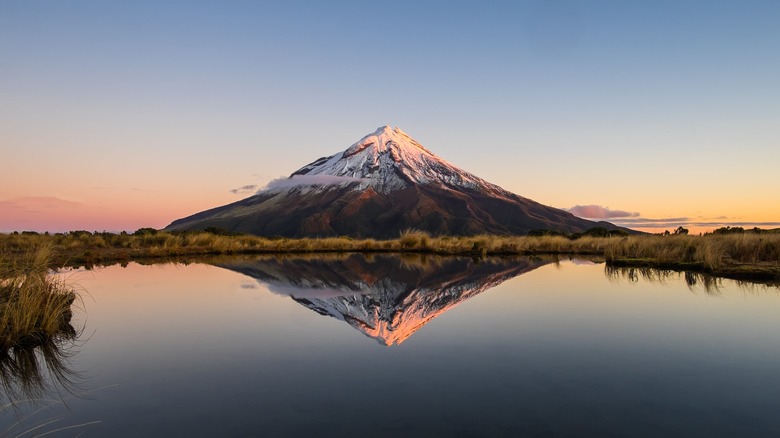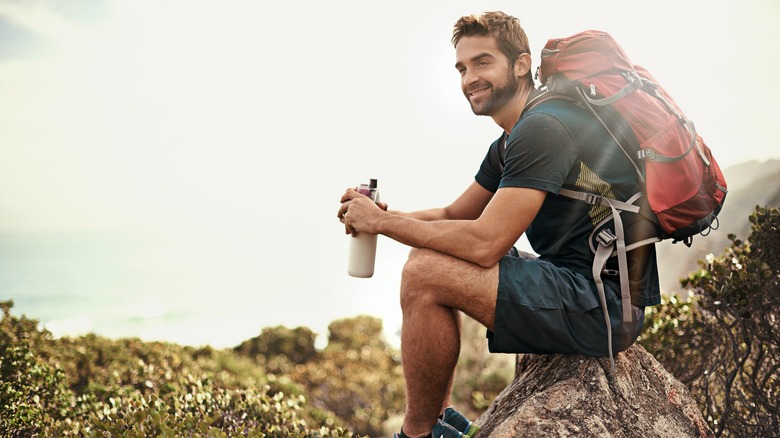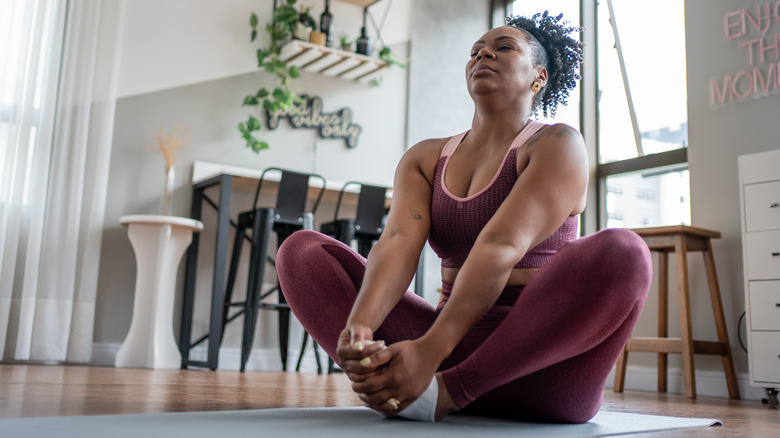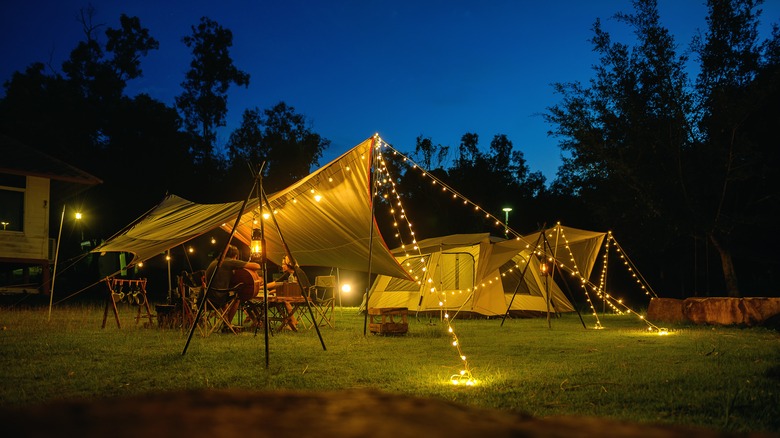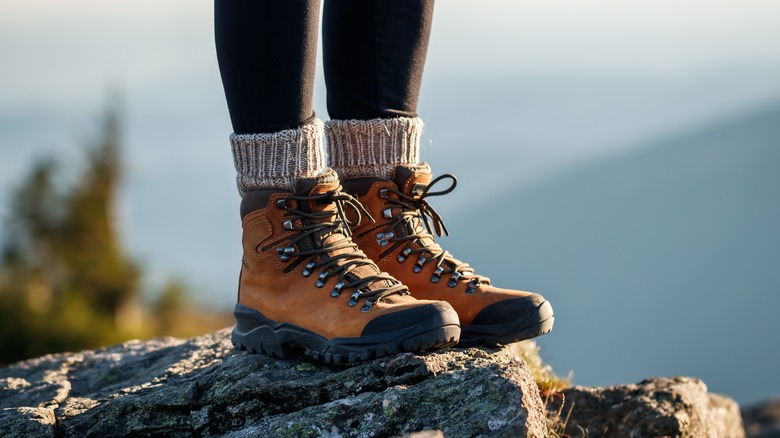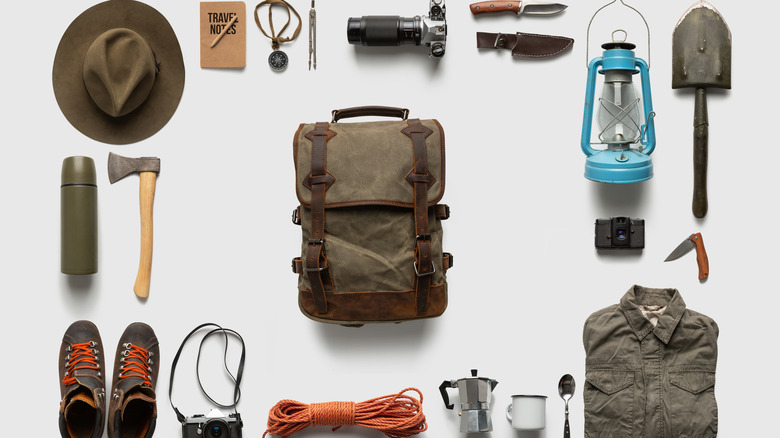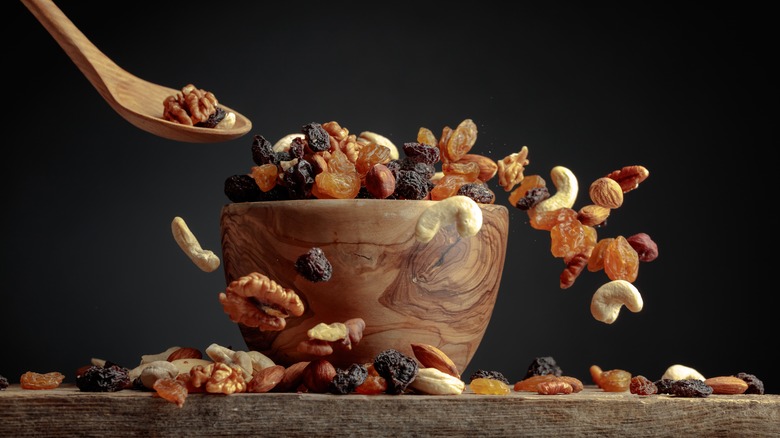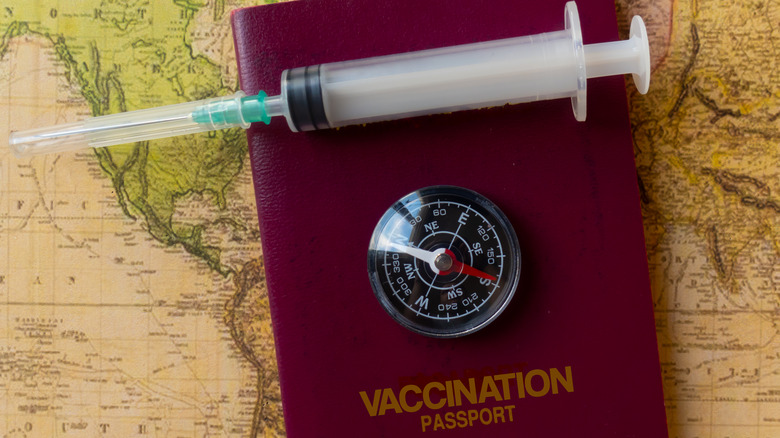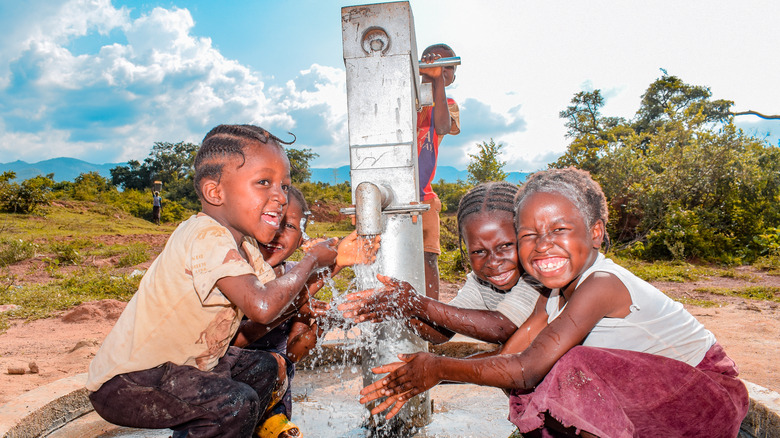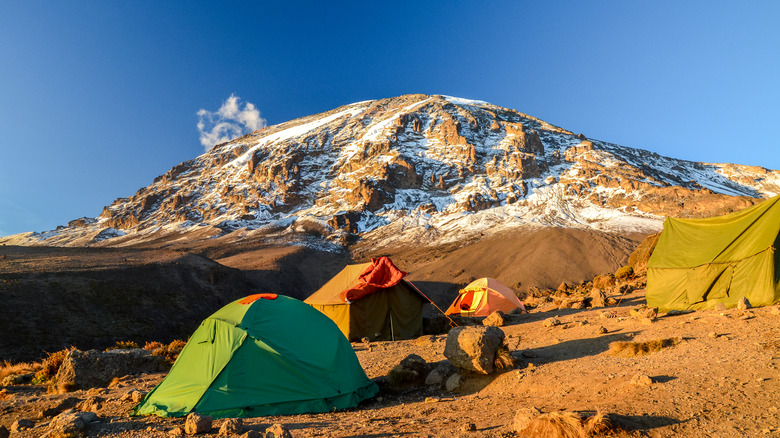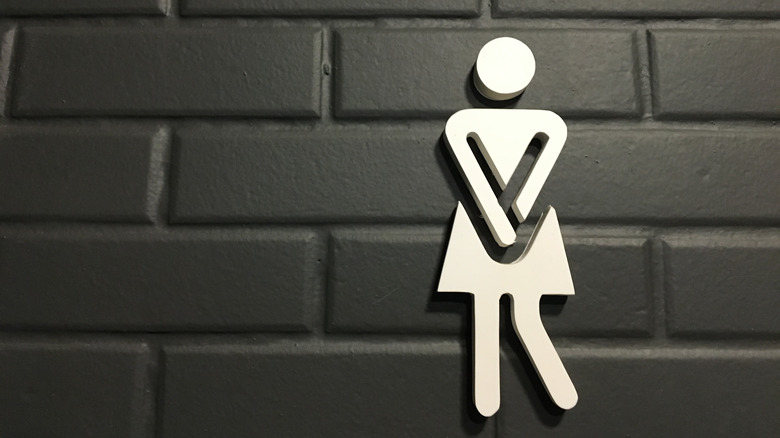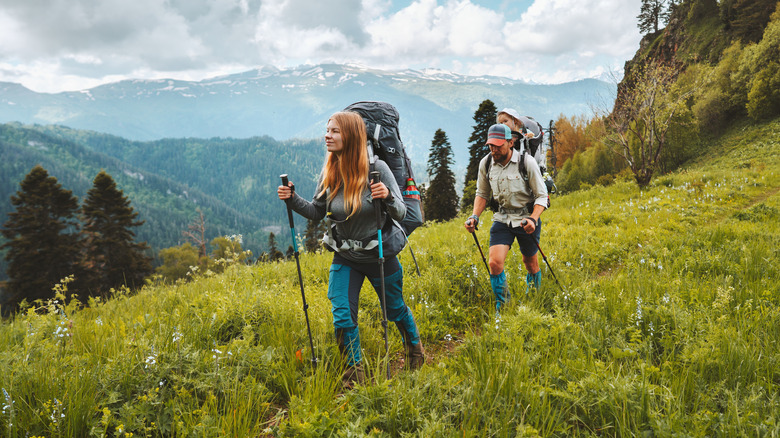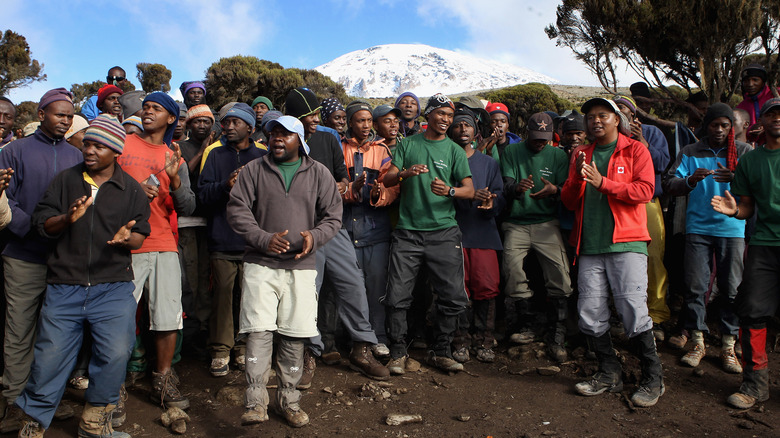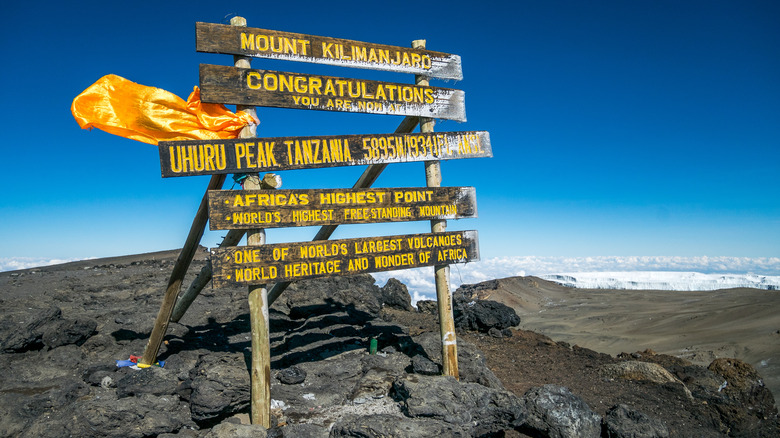Mount Kilimanjaro: The Complete Guide To Hiking The Famous Mountain
Everest, the Matterhorn, K2, Denali ... These famous mountains have entered into our collective psyche as towering obstacles that speak to the Earth's scenic glory. To that list you should add Tanzania's Mount Kilimanjaro, the tallest peak on the continent of Africa, and whose name means Mountain of Whiteness. Topping out at 5,895 meters, or 19,340 feet, it may be 10,000 feet less than Mount Everest (which reaches a shade more than 29,000 feet above sea level), but it's a monumental formation. Made up of three cones, and geologically a huge volcano made of ash and rock, it is remarkable for having the largest single-mountain ascent on the planet — it isn't part of any larger range. The sight of it rising like a solitary guard is incredible, its snow-capped peak appearing almost like frosting on a vast, conical cupcake is a sight that global warming might render obsolete in a few decades.
Mount Kilimanjaro was first summited in the late 1800s, and since adventurers don't need specialized mountaineering equipment or tanks of oxygen to conquer it, it's become a popular climbing destination. But don't let that fool you — getting to the summit is arduous, taking multiple days and insisting that travelers endure a range of conditions throughout. But once there, you'll see it's worth it — the mountain and surrounding national park are a Unesco World Heritage site after all, so enjoying the peak simply requires some sound preparation. Here's a good place to start.
Work out a budget
While Africa might have plenty of budget-friendly destinations, climbing Mount Kilimanjaro will cost a small fortune — think thousands of dollars. That's not surprising, since it's a days-long, labor-intensive expedition that requires not just payment for the guides, cooks, and porters that accompany you on the hike up and down, but also the various fees due in order to make the trip. On top of that, add in tips for the tireless staff that make this possible.
Fees certainly stack up quickly. You'll be charged per day for entry to the park as well as for campsites or huts that travelers will stay in. It's also a remote destination, closer to Kenya's capital Nairobi than Tanzania's capital Dar Es Salaam, but still not near any large city. The combination of these factors means that a climb here is usually for the truly committed and financially secure, often done to mark a special occasion or personal milestone.
Choose your operator wisely
A tour operator is a tour operator, right? In a word, no. This trip requires long days of walking over challenging terrain during conditions that can quickly swap cold with heat, and at high altitudes that makes everything 100 times harder. Sound like something you should take lightly? Of course not. So don't rush picking the operator, after all the journey is dangerous, and it's critical that you go with an outfitter that you are 100% comfortable with.
Always look for a reputable firm with good employee welfare, a proven safety history, and a healthy success rate — these are the most important aspects when sourcing who you will use as a guide for the quest. A good place to start is this list compiled by Colorado-based International Mountain Explorers Connection, which works directly with the Kilimanjaro Porters Assistance Project to ensure that those goals are met. The index offers more than 140 agencies around the world that are suitable choices.
Get in shape
Being in peak physical shape for this endeavor doesn't mean being able to run a few miles a couple of days a week, or having the strength to bench press your own body weight. A climb up Kilimanjaro is excruciating, and there's no denying that this slog will test your physical limits, not just because of the distances traveled each day that will test your muscles, but also the extreme altitude. It's key to be as fit as possible before the trip, and training should start at least two months in advance of the outing, with a regime that targets endurance and strength, as both are important.
In the gym, look to do weights, resistance training, and stretches, especially anything that works on the legs. For endurance, regular walks are vital, not just on flat terrain but also up and down hills (or stairs), and with weights or large bottles of water in a pack on your back — simulating the real conditions that you can look forward to!
Camp out
There are multiple routes (more on that later) to the summit of Kilimanjaro, and most of them require that hikers finish each day's travails at a campsite. This is pure wilderness, with no mountain retreats or luxury spa sojourns to close out the daily grind, so unless you are a tried-and-tested wilderness warrior, you need to accept that you'll be roughing it. Travelers will likely sleep each evening in tents, an environment that is very not for the needy and that, for the vast majority of us, takes some getting used to.
Practice what this will feel like beforehand by spending some nights in a tent at home, either indoors or in your backyard — or even better, at a campground. This way, you can see how your sleeping bags measures up, what clothes are most comfortable at night, if you need earplugs and an eye mask to get some slumber, and what laying down in a tent even feels like, all of which are actualities that you should be familiar with before you hit the mountain.
Medical matters
Altitude sickness isn't a euphemism for getting high (you can use that one for your next stand-up special). It is, in fact, a very real and dangerous condition where a person can't get enough oxygen into their bloodstream, making simple acts like breathing feel like momentous tasks. It generally occurs at altitudes more than 2,500 meters (or about 8,000 feet) above sea level, where there is less oxygen available in the atmosphere. Altitude sickness might look like intense headaches, nausea, and fatigue, and it can be life-threatening if not treated.
There is no cure for it, and medicines like Advil and Tylenol won't do much to curb its effects. Medicines like acetazolamide can weaken its symptoms, but your best bet is to bring canned oxygen with you to give yourself a literal boost of oxygen when your body can't seem to get enough of it. Be sure to bring that along, as well as multivitamins that can keep your immunity strong on the trip. With altitude also comes stronger effects of the sun, so high SPF sun protection, a broad-rimmed hat, and good, UV-filtering sunglasses, are crucial.
Wear in your boots
There are few sensations worse for the feet than that of breaking in new shoes. All that rubbing and chafing that mercilessly eats away at the skin to expose raw flesh is enough to make you squirm. While it might seem exciting to celebrate your trip to Africa by unveiling a new pair of hiking boots the night before starting the hike, don't do it. Bring along a pair of fully broken-in boots, preferably along with the socks that you've used to break them in. That way, your feet will feel snug and secure, carefully cosseted by a pair of glove-like footwear that is sturdy enough to withstand some serious battering.
Almost as important as your shoes is another item — trekking poles. You might associate these contraptions with old people looking to save their dodgy, creaking knees and help with their diminishing sense of balance, but these poles will be a lifesaver on the climb up and down the mountain. They'll help you traverse through the rocky and uneven parts of the mountain, offering some extra stability during your long hiking days.
Pack smartly
Sure you're in Africa, a continent that many of us associate with powerful sun and debilitating heat. But it gets cold here, very cold up on the mountain, so you need to pack clothing that will help you survive the cold at night but withstand the warmth that's generated once your body starts moving. Furthermore, conditions vary depending on the climbing season — June through October has finer weather, but the colder months of December through March window brings fewer tourists.
Your items need to be split between two bags. You'll carry one bag each day that is loaded with essentials like sunscreen, water, any valuables or documents, and a camera. Your other bag, which should weigh no more than 15 kg (about 33 pounds) is transported by a porter. This bag will hold your clothing, sleeping bag, and other gear like power banks or extra camera batteries. Since you are limited in what you can bring, layers are key, as are sweat-wicking clothing and warm socks and gloves.
Power up
The keys to succeeding in this climb are patience, belief, and stamina. That last one might be the most important, since the journey occurs over multiple days, and demands a steady, constant output of power and energy across that time. Conditioning will certainly help in that regard, making the exhausting, low-oxygen walkabouts each day manageable. But any mode of transportation — whether a plane, train, automobile, or your bag of flesh and bones — can't function without fuel.
Since weight and space are an issue during the adventure, small, high-power energy snacks are a smart choice, as all hikers will need nibbles that can keep them going when all hope seems lost. Don't get overly obsessed with ensuring that the snacks have the peak, Utopian nutritional combination — if there's a time to throw your obsession on low carbs, fats, salt, and sugar out of the window, it would be now — even glucose tablets will do in a pinch. It's amazing what a difference these can make to your stamina.
Ensure you're insured
While we hope and pray that they don't, bad things sometimes happen, even on vacation. Yes, these misfortunes can't be predicted, and so are unavoidable, but there are measures that can be taken to minimize financial repercussions from them. The most obvious of these is travel insurance, especially useful when your trip involves high-risk, potentially injurious activities — climbing Kilimanjaro clearly falls into this category. Not all travel insurance policies are the same, with limits and restrictions on coverage and varying deductibles.
For the sake of this specific journey, be sure to check whether any policy you are considering covers hiking in high altitudes, since many policies do not. At the same time as you are researching this aspect of the trip, double-check any entry and vaccination requirements for getting into Tanzania. Constantly monitor this — as we have all learned during the last couple of years, rules change quickly.
Learn a little Swahili
There's nothing that helps travelers connect more with the locals when they are visiting a place — any place — than speaking the same language. So learn some basic Swahili, a language commonplace throughout East Africa and whose origins can be traced to tongues spoken in sub-Saharan Africa and those brought by Arab traders. The language itself doesn't seem easy at first sight, words are often arranged in long combinations of vowels and consonants that look, and sound, unlike anything most English speakers will recognize.
But persevere, either with a phrase book or sites like this that provide sound clips to accompany the text. Practice the phrases before you head to Africa, and once there, practice some more. While you're unlikely to become fluent in the process, arming yourself with some words and greetings to use will definitely enamor you to the guides and porters — always a bonus — and soon, you might be swapping stories like old friends.
Choose the right route
The most important choice, beyond the training and what you pack and getting insurance, is how you'll approach the summit. Just as on peaks like Mount Everest, there isn't just one way up and down Mount Kilimanjaro — there are in fact seven different passages. Each of them has its own merits, so it's worth taking time to study each and communicating with your outfitter on which one will work best for you (the overall success rate for climbing Kilimanjaro is 65%).
One of the quickest routes is the Marangu Route, which in addition to taking about five or six days, is the only one with huts, so no camping is required. Might sound like a sound option, but consider that less time on the mountain means less time to acclimatize to low-oxygen conditions (and perhaps accounts for this route's lower completion rate). Other routes mostly differ in their length and distance, but as a general rule, the longer and slower the route, the greater your chances of success. Unless you are an expert climber, avoid the Umbwe Route — it's the shortest in distance, but it is also the hardest.
Get a private toilet
When nature calls, you'll have to go in nature, at least during the trekking part of each day, with the great outdoors doubling as the great restroom for all. But at camp each night, or at the huts, you have the option of the public toilets. These are foul-smelling wooden huts, not always with a door, where the toilet is actually a hole in the ground, meaning you'll need to squat (expect to feel the blood supply to your legs cut off after a couple of minutes of this) to succeed in your pursuit of an effortless evacuation.
It's hardly a pleasant place to do something that we are used to doing in maximum comfort, which is why smart trekkers shell out a bit extra for the (relative) luxury of a private toilet. This small lavatory, carried by a porter, comes with its own modest canopy, allowing you some privacy for your most private of missions.
Stay hydrated
We've all seen the statistics on how much water we are supposed to drink a day (approximately three liters), but a lot of us don't do that, and yet we seem to get through the day just fine. When hiking Mount Kilimanjaro though, skimping on the H2O just won't cut it. Even on the lower slopes, in the forest, it can be very warm and hydrating is critical when the body is sweating a lot. But perspiration isn't the only way to lose fluids at altitude here.
Other factors that could cause you to lose fluids include exposure to the sun when out of the tree canopy, and dehydration from the intake of cold, dry air at higher elevations. Loss of water can be debilitating, leading to fatigue, muscle ache, and nausea, which are not symptoms you'll want to endure during a climb. Most outfitters recommend imbibing around five liters per day on the climb, so drink like your life depends on it. It does.
Cleanliness is key
While the spiritually inclined might claim that cleanliness is next to godliness, climbers of Mount Kilimanjaro are more likely to proclaim that cleanliness is next to a successful ascent. It's vital to be hyper-obsessive about hygiene at all times here. You don't need to catch a pesky stomach bug while you're on a barren mountainside, it will ruin your enjoyment, and might even derail the whole adventure. There aren't showers or bathrooms with running water along the way, so bringing some simple supplies will guarantee that you complete the climb feeling fresh (it's all relative) and illness free.
Among the items that operators most stress are wet wipes (an easy way to refresh yourself with a quick swipe), disinfectant gel, and a reliable antiperspirant, while supplies like facial moisturizer and lip balm (the conditions will dry out your skin/lips in addition to your lungs). A razor, dry shampoo, and anything else to help you feel fresh are also recommended.
Pace yourself
Elite marathon runners train for years, pushing themselves past limits that most of us can't comprehend. Climbing Africa's tallest mountain, however, shouldn't feel like a race, so don't try to be the first past the post each day. You'll get more out of the experience by being part of the team and listening to your body, taking cues from those around you and your inner workings.
Trips up are usually done in small groups, and generally, the routes that take the longest number of days are the ones that offer the greatest success. The message: Slower is better. Take in the surroundings, the enormity of the experience, get used to the sensation of struggling with your breathing until it's no longer something that you notice, and speak to your fellow hikers, guides, and porters. The way you view your journey will make you realize that this is a team trial, not a sprint to succeed.
Appreciate your team
The team that accompanies you and your fellow walkers up the mountain comprises guides, cooks, and porters that do the heavy lifting, literally. These porters really do the bulk of the work, carrying your supplies and clothing (and private toilet if you choose this option), letting you concentrate on the climbing. It really is a thankless task — they balance largely packed duffels (filled mostly with your items) on their head — but it doesn't have to go unappreciated.
Look out for the local crew, talk to them, and most importantly tip them, as they rely on this income for the livelihood of themselves and their families. Most outfitters have guidelines on how much to tip each one, and payment is made in cash, either in U.S. Dollars (preferably with bills that are crisp) or Tanzanian Shillings. These tireless workers deserve the extra income — it's humbling to witness them charging ahead, carrying all the paraphernalia needed to get a bunch of well-off tourists up the mountain, and know they'll get to the bottom to do it all over again for the next herd.
Don't give up
The final climb and descent will be one of the most mentally challenging things you ever do. You wake up in the middle of the night, and fumble through in the dark, and the pre-dawn torture feels like it will last forever. As your body starts to move in the frigid air, you will be out of breath after every few steps, your muscles will burn, and your mind will keep telling you to quit, to stop, that this whole thing was a senseless folly.
But when you arrive, ready for sunrise at Stella Point, Gillman Point, or Uhuru Peak, (the three official summit points of the mountain) the experience becomes something otherworldly that you truly will never forget. Looking out from almost 20,000 feet above sea level, you'll realize that you are high enough that you can see the curvature of the Earth. What could be a more astonishing feeling than that?
